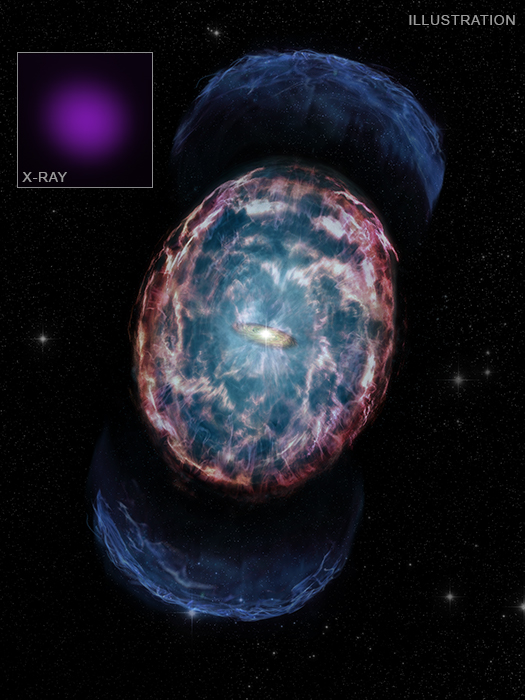For Release: February 28, 2022
NASA/CXC

Credit: X-ray: NASA/CXC/Northwestern Univ./A. Hajela et al.; Illustration: NASA/CXC/M.Weiss
Press Image, Caption, and Videos
Astronomers may have detected a “sonic boom” from a powerful blast known as a kilonova. This event was seen in GW170817, a merger of two neutron stars and the first object detected in both gravitational waves and electromagnetic radiation, or light.
A kilonova occurs when two neutron stars — some of the densest objects in the universe — merge. On Aug. 17, 2017, astronomers discovered gravitational waves from such a merger using the Advanced Laser Interferometer Gravitational-wave Observatory (LIGO) and Virgo, coinciding with a burst of gamma rays.
Since then, astronomers have been using telescopes all over the world and in space, including NASA’s Chandra X-ray Observatory, to study GW170817 across the electromagnetic spectrum. Chandra is the only observatory still able to detect light from this extraordinary cosmic collision more than four years after the original event.
"We have entered uncharted territory here in studying the aftermath of a neutron star merger," said Aprajita Hajela of Northwestern University, who led a new study of GW170817 with Chandra.
Astronomers think that after neutron stars merge, the debris generates visible and infrared light from the decay of radioactive elements like platinum and gold formed in the debris from the merger. This burst of light is called a kilonova. Indeed, visible light and infrared emission were detected from GW170817 several hours after the gravitational waves.
The neutron star merger looked very different in X-rays. Right after the initial LIGO detection was announced, scientists requested that Chandra quickly pivot from its current target to GW170817. At first, they did not see any X-rays from the source, but on Aug. 26, 2017, Chandra looked again and found a point source of X-rays.
This non-detection of X-rays quickly followed by a detection provides evidence for a narrow jet of high-energy particles produced by the neutron star merger. The jet is "off- axis" — that is, not pointing directly towards Earth. Researchers think that Chandra originally viewed the narrow jet from its side, and therefore saw no X-rays immediately after the gravitational waves were detected.
However, as time passed, the material in the jet slowed down and widened as it slammed into surrounding material. This caused the cone of the jet to begin to expand more into Chandra’s direct line of sight, and X-ray emission was detected.
Since early 2018, the X-ray emission caused by the jet had steadily been getting fainter as the jet further slowed down and expanded. Hajela and her team then noticed that from March 2020 until the end of 2020 the decline stopped and the X-ray emission was approximately constant in brightness. This was a significant sign.
"The fact that the X-rays stopped fading quickly was our best evidence yet that something in addition to a jet is being detected in X-rays in this source,” said co-author Raffaella Margutti of the University of California at Berkeley. “A completely different source of X-rays appears to be needed to explain what we’re seeing."
A leading explanation for this new source of X-rays is that the expanding debris from the merger has generated a shock, like the sonic boom from a supersonic plane. The emission produced by material heated by the shock is called a kilonova afterglow. An alternative explanation is that the X-rays come from material falling towards a black hole that formed after the neutron stars merged.
"This would either be the first time we've seen a kilonova afterglow or the first time we've seen material falling onto a black hole after a neutron star merger," said co-author Joe Bright, also from the University of California at Berkeley. “Either outcome would be extremely exciting.”
To distinguish between the two explanations, astronomers will keep monitoring GW170817 in X-rays and radio waves. If it is a kilonova afterglow, the radio emission is expected to get brighter over time and be detected again in the next few months or years. If the explanation involves matter falling onto a newly formed black hole, then the X-ray output should stay steady or decline rapidly, and no radio emission will be detected over time.
“Further study of GW170817 could have far-reaching implications,” said co-author Kate Alexander, also from Northwestern University. “The detection of a kilonova afterglow would imply that the merger did not immediately produce a black hole. Alternatively, this object may offer astronomers a chance to study how matter falls onto a black hole a few years after its birth.”
A paper describing these results appears in the latest issue of The Astrophysical Journal Letters and is available online. The team recently announced a source was detected in new Chandra observations of GW170817 performed in December 2021. Analysis of that data is ongoing. No radio detection in association with the emerging X-rays has yet been reported.
NASA's Marshall Space Flight Center manages the Chandra program. The Smithsonian Astrophysical Observatory's Chandra X-ray Center controls science operations from Cambridge, Massachusetts, and flight operations from Burlington, Massachusetts.
Media Contacts:
Megan Watzke
Chandra X-ray Center, Cambridge, Massachusetts
617-496-7998
mwatzke@cfa.harvard.edu


